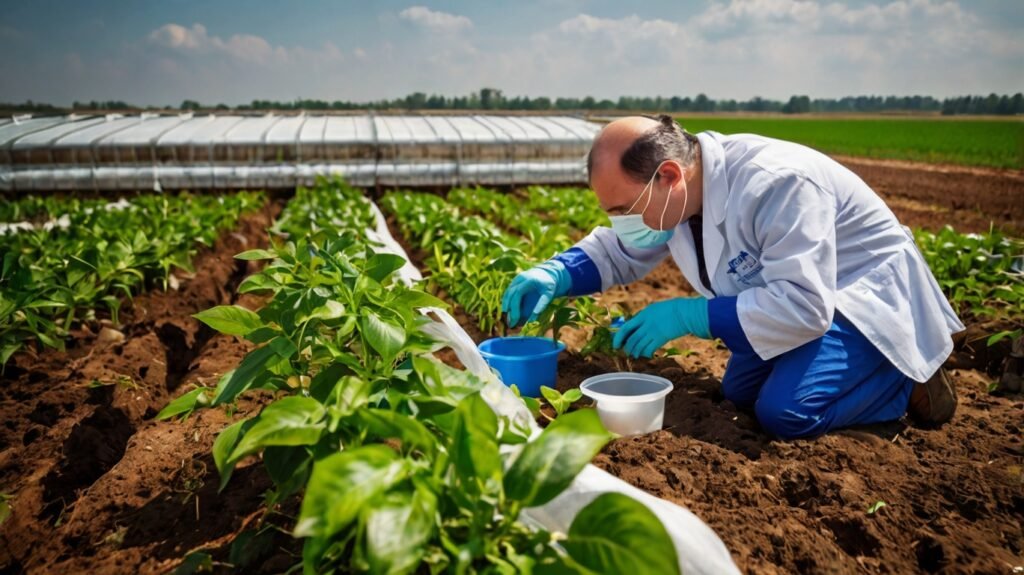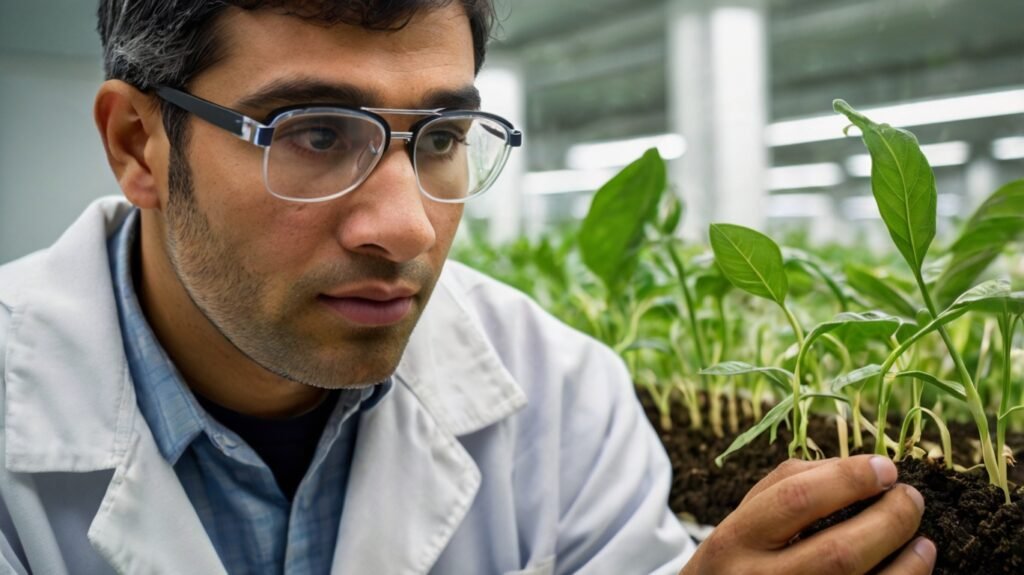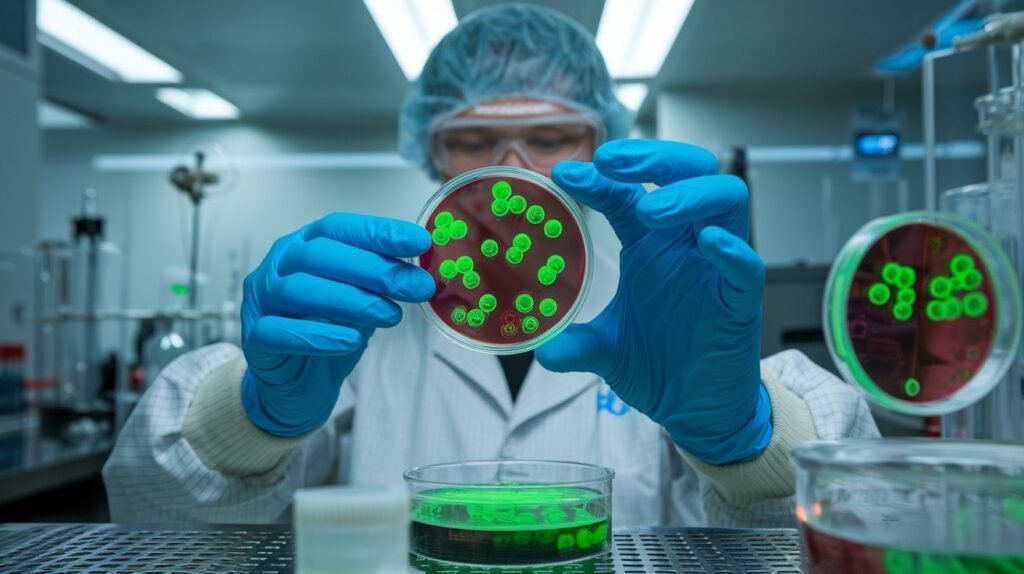Biotechnology in Agriculture
Biotechnology in Agriculture: Pioneering the Future of Farming

Table of Contents
ToggleIntroduction:
Agriculture has been an integral part of human civilization, forming the foundation of societies and driving economic development. With a global population expected to surpass 9 billion by 2050, the challenge of feeding this growing population while preserving environmental sustainability has never been more pressing. Biotechnology in agriculture offers transformative solutions that address these challenges by enhancing crop yields, improving resistance to pests and diseases, and optimizing resource use. This article explores the expansive field of agricultural biotechnology, detailing its principles, applications, benefits, and the various challenges it faces. We will also discuss the future prospects and potential innovations that could shape the future of farming. Click Here
“The Principles of Biotechnology in Agriculture”
Understanding Biotechnology:
Biotechnology harnesses biological systems, organisms, or derivatives to develop new technologies and products. In agriculture, biotechnology is used to improve crops and livestock, develop new agricultural products, and enhance environmental sustainability.Some of the very important techniques that have emerged include genetic engineering, molecular markers, tissue culture, and cloning.
Genetic Engineering:
Genetic engineering involves the manipulation of organisms to incorporate new desirable traits or to modify certain characteristics that may already be present. This process allows scientists to create crops with specific desirable characteristics, such as resistance to pests or enhanced nutritional content. Key methods include:
Gene Insertion: Adding new genes into an organism’s DNA. This can introduce new traits that were not present in the original organism.
Gene Editing: Making precise modifications to the existing genes of an organism. Tools like CRISPR-Cas9 allow for targeted changes at specific locations in the genome.
Transgenesis: Involves transferring genes from one species to another. For example, inserting a gene from a bacterium into a plant to provide pest resistance.
Molecular Markers:
Molecular markers are tools used to identify specific genes or traits in plants and animals. These markers assist in tracking genetic variations and selecting for desirable traits more efficiently than traditional methods. Key types include:
Restriction Fragment Length Polymorphisms (RFLPs): Variations in DNA sequences that are useful for genetic mapping and identification.
Simple Sequence Repeats (SSRs): Repeated sequences of DNA that are highly variable among individuals and useful for genetic diversity studies.
Single Nucleotide Polymorphisms (SNPs): Variations in a single nucleotide in the DNA sequence that can be linked to specific traits or diseases.
Tissue Culture and Cloning:
Tissue culture and cloning involve growing plants from small tissue samples or cells. This technique is used to propagate plants with desirable traits, produce disease-free plants, and conserve genetic resources. Applications include:
Micropropagation: Growing large numbers of plants from a small tissue sample in a controlled environment. This method is used to rapidly produce uniform plant materials.
Somatic Cloning: Creating genetically identical plants through somatic cell nuclear transfer. This technique is used to propagate plants with superior traits.
“Positive Impacts of Biotechnology in Farming”
Biotechnology has emerged as a transformative force in modern agriculture, offering innovative solutions that enhance productivity, sustainability, and resilience. The integration of biotechnological advancements into farming practices brings numerous positive impacts, contributing to a more efficient and sustainable food production system. This article delves into the various ways Biotechnology in Agriculture positively affects farming, highlighting its benefits for farmers, consumers, and the environment.
Enhanced Productivity:
One of the most significant benefits of biotechnology in farming is the increase in crop yields. By developing genetically modified (GM) crops that possess traits such as resistance to pests, diseases, and environmental stresses, Biotechnology in Agriculture enables farmers to produce more food per unit of land. For example:
Pest-Resistant Crops: Crops engineered with genes from the bacterium Bacillus thuringiensis (Bt) produce proteins that are toxic to specific insect pests. Bt cotton and Bt corn are well-known examples that have significantly reduced the need for chemical insecticides and led to higher yields.
Drought-Tolerant Varieties: Biotechnological advancements have led to the development of drought-resistant crops that can withstand periods of water stress. These varieties ensure stable yields even under challenging climatic conditions, contributing to food security in regions prone to drought.
“Applications of Biotechnology in Agriculture”
Biotechnology has a wide range of applications in agriculture, impacting various aspects of crop and livestock production. These applications include genetically modified crops, biofortification, pest management, and soil and water management.
Genetically Modified (GM) Crops:
Genetically modified crops are engineered to have specific traits that enhance their performance and resilience. The introduction of these traits has significantly impacted agricultural practices and productivity.
Pest and Disease Resistance:
GM crops can be engineered to resist pests and diseases, reducing the reliance on chemical pesticides and increasing crop yields. Examples include:
Bt Crops: These crops contain a gene from the bacterium Bacillus thuringiensis, which produces a protein toxic to certain insect pests. Bt cotton and Bt corn are notable examples that have significantly reduced the need for chemical insecticides.
Disease-Resistant Varieties: Genetic modifications can confer resistance to various diseases. For instance, genetically modified papaya has been developed to resist the ringspot virus, saving the industry from potential devastation.
Herbicide Tolerance:
Herbicide-tolerant crops have been engineered to withstand specific herbicides, allowing farmers to use these herbicides for weed control without harming the crop. This has led to:
Improved Weed Management: Herbicide-tolerant crops enable effective control of weeds, reducing competition and increasing crop yields.
Reduced Tillage: The ability to use herbicides rather than mechanical weeding reduces soil disturbance and erosion, contributing to soil health.
Enhanced Nutritional Content:
In fact, through nutritional improvement of food, it may work to realistically improve nutritional deficiencies within the diets of various populations. Examples include:
Golden Rice: Engineered to produce higher levels of provitamin A (beta-carotene), Golden Rice aims to combat vitamin A deficiency, particularly in developing countries where rice is a staple food.
Biofortified Crops: Crops such as biofortified beans and sweet potatoes are enriched with essential nutrients like iron, zinc, and folate, improving public health and nutritional status.
Biofortification:
Biofortification involves increasing the nutritional value of crops through biological means. This can be achieved through various approaches:
Genetic Enhancement: Introducing or enhancing genes responsible for nutrient accumulation. For example, genetically modifying maize to increase its lysine content, an essential amino acid.
Soil and Agronomic Practices: Enhancing soil with nutrients or using specific fertilizers to improve crop nutrient content. Techniques include applying zinc-enriched fertilizers to increase zinc levels in cereal crops.
Pest Management:
Biotechnology offers innovative solutions for pest management, reducing the reliance on chemical pesticides and promoting sustainable practices.
Integrated Pest Management (IPM):
IPM is a comprehensive approach that combines biological, physical, and chemical methods to manage pests effectively. Biotechnology contributes to IPM through:
Biopesticides: Using natural or engineered organisms to control pests. Examples include microbial agents like Bacillus thuringiensis and Trichoderma species, which can suppress pest populations and reduce the need for synthetic pesticides.
Genetic Control: Developing genetically modified crops that are resistant to pests or diseases, reducing the need for chemical treatments and contributing to more sustainable pest management.
Pest-Resistant Varieties: Creating crops with inherent resistance to pests and diseases through genetic engineering, minimizing the impact of pest infestations and improving crop health.
Soil and Water Management:
Biotechnology also plays a crucial role in enhancing soil and water management practices, essential for sustainable agriculture.
Soil Microbiome Engineering:
The soil microbiome is a diverse community of microorganisms, critical in nutrient cycling, soil health, and plant growth. Biotechnology in Agriculture can improve soil health through:
Beneficial Microbes: Introducing or enhancing microbes that improve soil fertility, enhance nutrient availability, and suppress soil-borne diseases. For example, bioinoculants containing beneficial bacteria or fungi can enhance plant growth and nutrient uptake.
Soil Structure Improvement: Using microbial inoculants to enhance soil structure, water retention, and aeration. This can lead to improved soil quality and better crop performance.
Water-Use Efficiency:
Efficient water use is crucial for agriculture, particularly in regions facing water scarcity. Biotechnology contributes through:
Drought-Resistant Crops: Developing crops that can tolerate periods of water stress, reducing the need for irrigation and improving resilience to changing climate conditions.
Efficient Irrigation Systems: Designing and implementing irrigation systems that optimize water use and minimize waste. Advances in sensor technology and data analytics enable precision irrigation practices that improve water efficiency.
“Benefits of Biotechnology in Agriculture”
The application of biotechnology in agriculture offers numerous benefits, transforming farming practices and improving outcomes for farmers, consumers, and the environment.
Increased Crop Yields:
Biotechnological innovations have led to significant increases in crop yields by developing varieties that are more resistant to pests, diseases, and environmental stresses. This helps meet the food demands of a growing global population and contributes to food security.
Reduced Agricultural Chemicals:
Biotechnology has reduced the need for chemical inputs such as pesticides and herbicides. GM crops with built-in pest resistance or herbicide tolerance decrease the reliance on chemical treatments, benefiting both the environment and human health. This reduction in chemical use contributes to the preservation of ecosystems and minimizes the risks associated with pesticide exposure.
Enhanced Nutritional Content:
Biofortified crops provide essential nutrients that can improve public health, particularly in regions where nutrient deficiencies are prevalent. Enhanced nutritional content addresses deficiencies in vitamins and minerals, contributing to better overall health and reducing the prevalence of diet-related diseases.
Environmental Sustainability:
By reducing the need for chemical inputs and improving resource efficiency, Biotechnology in Agriculture contributes to more sustainable agricultural practices. Key environmental benefits include:
Reduced Soil Erosion: Conservation tillage practices enabled by herbicide-tolerant crops help reduce soil erosion, preserving soil health and structure.
Lower Greenhouse Gas Emissions: Reduced reliance on chemical inputs and improved crop efficiency can lower greenhouse gas emissions associated with agriculture, contributing to climate change mitigation efforts.
Resource Conservation: Biotechnology can lead to more efficient use of water, nutrients, and land, helping to conserve natural resources and promote sustainable agricultural practices.
Economic Benefits:
Farmers benefit from increased yields, reduced input costs, and improved crop quality. These advantages can lead to higher profits, greater food security, and enhanced economic stability in rural areas. Biotechnological innovations also create opportunities for new markets and industries, driving economic growth and development.
“Challenges and Controversies”
Despite its many benefits, biotechnology in agriculture faces several challenges and controversies that need to be addressed. These include environmental concerns, health and safety issues, socioeconomic implications, and ethical and cultural considerations.
Environmental Concerns:
Biodiversity: There are concerns about GM crops potentially affecting non-target organisms and reducing biodiversity. The potential for unintended ecological impacts requires careful monitoring and assessment to ensure that GM crops do not adversely affect ecosystems.
Gene Flow: The risk of GM crops crossbreeding with wild relatives or non-GM crops could create “superweeds” or other unintended consequences. Managing gene flow and monitoring potential impacts are essential to mitigate these risks.
Health and Safety:
Food Safety: The safety of GM foods is a topic of ongoing debate. Concerns about allergenicity, potential long-term health effects, and the need for rigorous testing and regulation persist. Ensuring that GM foods undergo thorough safety evaluations and regulatory scrutiny is crucial to address these concerns.
Resistance Development: The potential for pests or diseases to develop resistance to GM traits or biopesticides can undermine their effectiveness. Integrated pest management strategies and resistance management practices are necessary to address this issue and maintain the effectiveness of biotechnological solutions.
Socioeconomic Issues:
Access and Equity: There are concerns about the accessibility of biotechnological innovations to smallholder farmers and developing countries. Ensuring equitable access to technology and addressing disparities in resources and infrastructure is important for global agricultural development.
Intellectual Property: The patenting of genetic material and Biotechnology in agriculture processes raises issues of ownership and access to technology. Balancing intellectual property rights with access to innovation is a key consideration to promote fair and equitable use of biotechnological advancements.
Ethical and Cultural Concerns:
Labeling: The debate over whether GM foods should be labeled continues, with differing views on transparency and consumer choice. Clear labeling practices can help address consumer concerns and preferences, allowing individuals to make informed decisions about the foods they consume.
Cultural Acceptance: Different cultures have varying perspectives on genetic modification. Understanding and respecting cultural attitudes and beliefs is important for the acceptance and adoption of biotechnological innovations. Engaging with diverse stakeholders and considering cultural contexts can help foster acceptance and support for biotechnology in agriculture.
“The Future of Biotechnology in Agriculture”
The future of biotechnology in agriculture is poised to bring further advancements and innovations. Emerging technologies and research hold the potential to revolutionize agriculture even more profoundly.
CRISPR and Gene Editing
CRISPR-Cas9 is a groundbreaking gene-editing tool that allows for precise modifications to an organism’s DNA. This technology offers several advantages:
Precision: CRISPR enables targeted changes to specific genes, reducing the likelihood of unintended effects and increasing the accuracy of genetic modifications.
Efficiency: Gene editing is faster and more cost-effective compared to traditional genetic modification methods, accelerating the development of new crop varieties and improving agricultural practices.
Applications: CRISPR has the potential to create crops with enhanced traits, such as improved disease resistance, better nutritional content, and increased yield. And this is also very promising technology that could greatly improve farming, especially with regard to the breeds of livestock and help solve some agricultural problems.
Synthetic Biology:
Synthetic biology includes the design and construction of new biological parts, devices, and systems. In agriculture, synthetic biology could lead to:
Novel Crop Varieties: Creating entirely new crops with tailored traits to meet specific agricultural needs. For example, developing crops that can thrive in extreme environmental conditions or have enhanced nutritional profiles.
Innovative Pest Control: Using synthetic biology to develop new methods for pest and disease management, such as engineered microorganisms that target specific pests or diseases without affecting non-target organisms.
Advanced Breeding Techniques:
Advanced breeding techniques, such as genome-wide association studies (GWAS) and marker-assisted selection (MAS), are enhancing traditional breeding methods. These techniques enable:
Precision Breeding: Identifying and selecting for desirable traits more accurately and efficiently, accelerating the development of improved crop varieties.
Accelerated Breeding: Speeding up the breeding process to develop new crop varieties and improve crop performance more rapidly. This can help address urgent agricultural challenges and meet the needs of a growing population.
Big Data and Artificial Intelligence:
Big data and artificial intelligence (AI) are transforming agriculture by providing valuable insights and improving decision-making. Applications include:
Predictive Analytics: Using data to forecast crop yields, optimize resource use, and manage risks. Predictive models allow farmers to make better decisions about planting, irrigation, and pest management.
Precision Agriculture: Leveraging AI and data analytics to tailor farming practices to specific field conditions and crop needs. This includes optimizing input use, monitoring crop health, and managing environmental impacts.
Conclusion:
Biotechnology in agriculture represents a transformative force with the potential to address some of the most pressing challenges facing global food systems. From increasing crop yields and reducing the need for chemical inputs to enhancing nutritional content and promoting environmental sustainability, biotechnological innovations offer a wealth of benefits.
However, the challenges and controversies associated with Biotechnology in Agriculture underscore the need for ongoing research, dialogue, and regulation. By balancing innovation with careful consideration of environmental, health, and socio-economic factors, Biotechnology in Agriculture can continue to play a crucial role in shaping the future of agriculture.
As we look to the future, Biotechnology in Agriculture will remain a vital tool in our quest to feed a growing global population while preserving the planet’s resources. The continued development of biotechnological techniques, coupled with thoughtful and inclusive approaches to their implementation, will be essential in ensuring that the benefits of biotechnology are realized in a way that is equitable, sustainable, and respectful of diverse perspectives.
With ongoing advancements in gene editing, synthetic biology, and data-driven approaches, Biotechnology in Agriculture holds the promise of a new era in agriculture—one where food production is more efficient, resilient, and capable of meeting the needs of a dynamic and diverse global population. The journey of biotechnology in agriculture is far from complete, and its future will undoubtedly bring new opportunities and challenges that will shape the way we cultivate the land and nourish the world.









